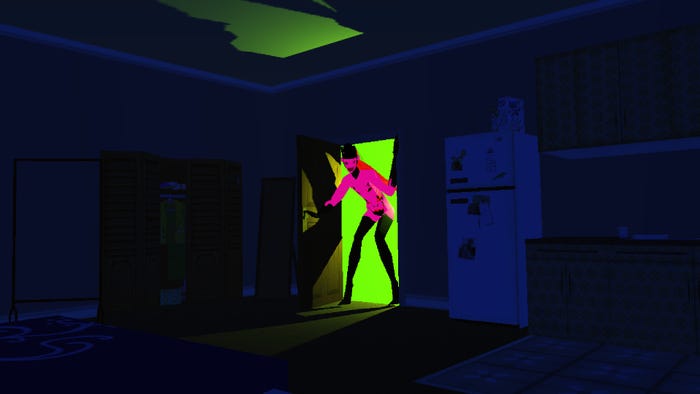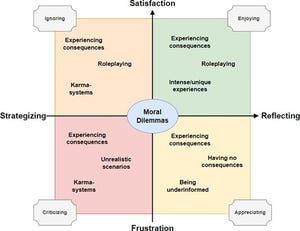
Featured Blog | This community-written post highlights the best of what the game industry has to offer. Read more like it on the Game Developer Blogs.
Logic In Motion: How Motion Controls Can Overcome the Hurdles of Gamers' Logic
Can well-implemented motion controls finally conquer the challenge of helping non-gamers understand 'gaming logic'?


Logic is a curious thing. When a selection of people are given an identical puzzle, the chances of them all resolving it in the same way is virtually nil. Several might not be able to get their heads around it at all, whereas others will be working towards a solution within seconds.
A frequently cited complaint amongst non-gamers as to why they choose not to participate in the medium is because it seems too complicated. Gamers retort that practice makes perfect, but this isn't entirely true: for many people, the process of pressing buttons (let alone combinations) on a controller to invoke specific actions from an avatar on-screen that all of us take for granted, seems to them unrelated and illogical. Why does one button make the character do one thing and another something else?
This is why simpler games, which only involve inputs from one or two buttons, are often the most popular. Two-dimensional Mario games, for example, are the quintessential example of being easy to pick up but difficult to master. Members of my family who have never had much interest in gaming pick up early Mario titles without any trouble outside the first few minutes when they're still getting used to where the jump and run buttons are.
After that, they have all the skills that I have after twenty years of gaming, albeit with a few rough edges (timing jumps and whatnot) that experience quickly irons out. For us regular gamers, picking up any controller feels second nature and with a glance, we are able to move our thumbs to the right buttons without a thought. For non-gamers who have difficulty making the leap between button input and on-screen action, these are all things they have to memorise and the more things they have to remember, the more unnatural and frustrating the experience becomes.
But remembering where the buttons are and what they do is only part of the problem. There's also the issue of when is the right time to press those buttons and what effect they will have on the world. If controller difficulties can be partially resolved through memory and training, applying those inputs to the context of the worlds on-screen presents a whole new range of questions. Where gamers know to look for certain visual cues from years of experience, the non-gamer will not see them because they can only contextualise the in-game logic through their experience of real-world logic.
How do you know when to press an 'action' button and what action it will have? Maybe I want an action button to do one thing, yet it either ignores the input or does something else. Even in a well-made game with clearly defined rules, these issues which gamers feel no need to question become sources of puzzlement for those not fluent in the lingo. I tried introducing my grandmother to New Super Mario Bros Wii, but she found it impossible to decypher the meaning of many of the in-game objects: which blocks can be smashed? Which objects are enemies and which are items? Simple as it seems to us, on an objective level there is little to tell us to walk over the mushroom and avoid the goomba. Gamer logic is ingrained in design and taken for granted more deeply than we can imagine.
This isn't an argument to suggest that we should try to do away with gamer logic. Any form of interactive play, be it a board game or children fighting with sticks, requires a certain amount of imaginative leaps of thinking in order to acquire and make sense of the rules. However, I do think that if gaming is to achieve genuine recognition as a cornerstone of expressive culture, it will need to rethink many of the rules of design to make them more accessible to a greater number of people.
Everyone reading this will probably have guessed that the Nintendo Wii was going to crop up at some point. You saw 'motion controls' in the title, the terms 'non-gamers' and 'accessible' in previous paragraphs, and the result was obvious. But would someone not versed in gaming culture have made that leap? There's no particularly deep point to this little diversion, other than to reinforce how contextual and arcane the concept of logic really is. 
In fact, my train of thought on this subject was inspired by the announcement of the Sony 'Move' controller. All reactions to it so far have been based on price points, how responsive it is, the controllers' aesthetic design and how the games demoed are mostly derivative of experiences already available on the Wii. It occurred to me that none of these things really matter in defining whether or not the device will be embraced or not. Maybe price, but what I'm really interested in is how people will react once the device is in their hands.
Because while most gamers have chosen to remember the Wii's lauch with a certain cynicism (in the same way the original Matrix film got 'reappraised' once the sequels were not well received), the truth is that there was quite a lot of excitement across the gaming community at the time. Messageboards were packed with people speculating about the new experiences motion controls could offer.
Most of them were absurd, but the new control method was an idea people engaged with. Microsoft might be the darling right now, but they and Sony were subject to a fair bit of criticism at the time for simply offering a tech upgrade. Time changes minds, but that's a whole other blog.
While Wii Sports is now looked back on as the demonic destroyer of 'hardcore' (there's another term that has changed definition several times over several console generations) gaming, it was broadly deemed a success at launch (tennis, bowling and golf anyway). Simple as the games were, gamers enjoyed being able to share their hobby with their families and non-gaming friends. Reasons as to the Wii's success veer between the unintimidating graphics to the simplistic natures of the games on offer. Whatever the reason, it certainly wasn't one compatible with the genres 'hardcore' gamers liked to associate themselves with.
My feeling is that the Wii's success came because motion controls offered a means to overcome the difficulties of gaming logic. Wii Sports is accessible because it replaced the difficulty of pressing a button with a motion which can be logically associated with its action on-screen. Swing the remote to swing your racket or golf club. No need to remember where a button is, or have to overcome the question of why one button does one thing and another elsewhere does something different.
The only button inputs are simple enough to be no more difficult than remembering the rules of a board game. As for their being inapplicable to more mainstream genres, many of the minigames in Wii Play are simplified versions of games that 'real' gamers play every day. In a subtle way, Nintendo were training non-gamers in the basic functions of more traditional genres: shooting range is a static FPS. Cow racing teaches the basics of racing games. The sports games expand on what was offered by Wii Sports. Tanks is a lesson in how to move a third-person avatar and shoot at the same time. 
My theory as to the reason 'casual' games tend to succeed on the console is because they continue Nintendo's work in providing new gamers with a skillset that doesn't require overcoming the complications of traditional gamer logic. In my experience, new gamers haven't been too fussed about a game's controller not being 100% responsive: as long as they can relate to the mechanics and the game is fun, issues of lag or small imprecisions don't really matter, at least at first.
Over time, many non-gamers I know have expressed a desire to try more complex games, but the problem is that very few traditional game developers have bothered to adapt their design to the new possibilities and challenges of integrating motion control in an understandable way. Even Nintendo games like Mario Galaxy have failed to utilise the gestural aspects of its control scheme in a logical manner. When motions do not relate to actions on-screen, they're no more help to non-gamers than a traditional button-based controller.
I've had more success in bringing new gamers to Call of Duty on Wii because they can make more sense of aiming with the pointer and moving with the analogue stick, than having to work out the more inaccessible controls of Mario Galaxy. ExciteTruck and Mario Kart Wii work not because they're simple games, but because they build on the training non-gamers received in the racing part of Wii Play (the Wii Wheel, derided as it was, also provides them with an object that contextualises the controller so they hold it in the correct fashion).
New gamers are not idiots who can only enjoy a game painted in primary colours and with no more than one or two game mechanics. Their logic simply works differently to ours and if you give them a way into a more complex game, they will grasp it with as much enthusiasm as a traditional gamer does with a controller.
If motion controls are to achieve their full potential, whether made by Nintendo, Sony or Microsoft, developers will have to put greater thought into what they want to achieve in integrating gestures into their games and the changes in the way games are designed that will inevitably come about as a result. Motion controls can offer non-gamers a logical entry point into more complex genres without alienating traditional gamers, who can benefit from the greater sense of immersion that well-integrated gestures can offer: having recently returned at a friend's house to twin analogue stick FPS controls for the first time since swapping them for Wii pointer aiming, I was shocked at how imprecise and clunky they felt.
As the technology improves, gamers will be more receptive to trying out these new experiences. Developers should also seize this opportunity to look at the way the content in their game is designed: puzzles that can be solved using logic independent of the gaming mindset not only broadens the potential audience, but also means that players can be left to devise solutions on their own without immersion-breaking signposting, creating a more self-sustaining and confident experience.
There is no reason to continue thinking about 'casual' and 'hardcore' gamers and games as independent of one another, when each has design lessons to teach the other that can lead to more accessible, immersive and enjoyable experiences for all, with motion controls bridging the divide.
About the Author(s)
You May Also Like













